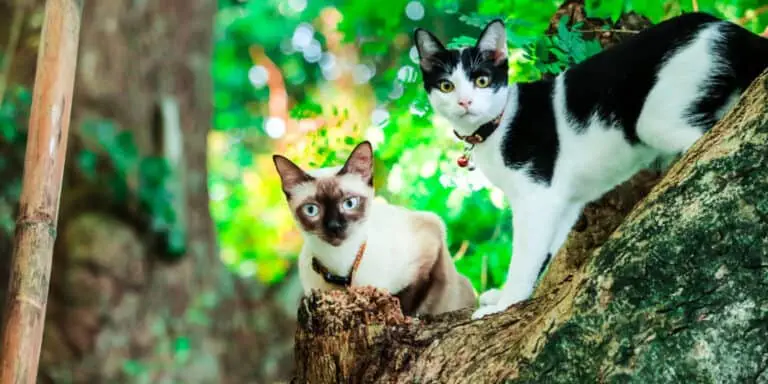The Best Fluffy Pancakes recipe you will fall in love with. Full of tips and tricks to help you make the best pancakes.

Are you considering getting a Siamese cat, but worried about their reputation for being aggressive?
Siamese cats are not inherently more aggressive than other cat breeds. However, they can be more vocal and demanding of attention, which may be misconstrued as aggression.
It is important to note that the temperament of a cat depends on various factors, including their individual personality and how they are raised and socialized.
It’s a common misconception that all Siamese cats are inherently aggressive, but the truth is that their behavior is influenced by a variety of factors. Understanding the history and characteristics of Siamese cats, as well as the nature vs. nurture debate in cat behavior, can help you make an informed decision about whether a Siamese cat is the right pet for you.
Siamese cats have a long and fascinating history, with origins dating back to ancient Siam (now Thailand). They were highly prized by royalty and were often given as gifts to foreign dignitaries.
Siamese cats are known for their striking appearance, with their distinctive pointed markings and bright blue eyes. However, they are also known for their vocal and demanding personalities, which can sometimes be mistaken for aggression.
In this article, we will explore the various factors that can influence Siamese cat behavior and provide tips for preventing and managing aggression in these beautiful cats.
The History and Characteristics of Siamese Cats
You’re probably curious about the history and characteristics of Siamese cats, so let’s dive in! The Siamese cat is one of the oldest and most recognizable breeds of cats in the world. Its origins can be traced back to ancient Siam, which is now known as Thailand.
Siamese cats were highly valued by the royal family, and it was forbidden for anyone except the king and his family to own them. In 1884, the first Siamese cat was brought to England and quickly became popular due to its unique appearance and personality traits.
Siamese cats are known for their distinctive, sleek appearance, which includes bright blue eyes, a pointed face, and a slender body. They are also known for their outgoing and curious personalities. Siamese cats are highly intelligent and social animals that crave attention and affection from their owners. They are also known for their vocalizations, which can range from soft purring to loud meowing.
Siamese cats are also very active and playful, making them great companions for families with children or other pets. The Siamese cat is a fascinating breed with a rich history and unique personality traits. Their origins in ancient Siam make them a highly prized and valued breed, and their distinctive appearance and outgoing personalities make them a popular choice for cat lovers all over the world.
If you’re considering adding a Siamese cat to your family, be prepared for a social, intelligent, and playful companion that will bring you years of joy and companionship.
The Nature vs. Nurture Debate in Cat Behavior
Understanding cat behavior is a complex topic that involves exploring the interplay between nature and nurture. While genetics may play a role in a cat’s behavior, environmental influences are equally important.
Like humans, cats need to be socialized properly to develop their personality and behavior. While some cat breeds may have certain predispositions, such as the Siamese breed being known for being vocal and active, it is important to remember that each cat is an individual with its own unique personality.
The nature vs. nurture debate in cat behavior is ongoing, and it is difficult to draw a clear line between genetics and environmental factors in a cat’s behavior.
If you are a cat owner, it is important to understand the role that the environment plays in your cat’s behavior. Providing a stimulating and comfortable living environment can go a long way in shaping your cat’s behavior. Positive reinforcement and socialization are also key in helping your cat develop good behavior habits.
Remember to be patient and consistent in your training methods, and seek professional help if needed.
Genetic Influences on Cat Behavior
Did you know that your furry friend’s personality and behavior may be influenced by their genetic makeup? Inherited traits play a crucial role in determining a cat’s behavior.
Certain breeds have been selectively bred for specific traits, such as the Siamese cat’s distinctive personality. However, it’s important to note that not all cats of the same breed will exhibit the same behavior, as environmental factors also play a role.
Breeding practices can also affect a cat’s behavior. Inbreeding, for example, can increase the likelihood of certain genetic disorders and may contribute to more aggressive behavior. On the other hand, responsible breeding practices can result in healthier and well-behaved cats.
Breeders who prioritize temperament and personality traits in their breeding programs can produce cats with more desirable behavior.
While genetics may play a role in a cat’s behavior, it’s important to remember that environmental factors also have a significant impact. Socialization, training, and daily interactions with their human families can greatly influence a cat’s behavior.
As a responsible cat owner, it’s important to provide a safe and stimulating environment for your furry friend, and to seek professional help if you notice any concerning behavior.
Environmental Factors that Affect Cat Behavior
Environmental factors can have a significant impact on a cat’s behavior, as the saying goes, “a cat’s behavior reflects its environment.”One important environmental factor that can affect a cat’s behavior is enrichment activities.
Enrichment activities are designed to stimulate a cat’s mind and body, and they can help to prevent boredom, which can lead to destructive or aggressive behavior. There are many different types of enrichment activities that can be used to help improve a cat’s behavior.
Some examples include providing toys for the cat to play with, creating a comfortable and safe space for the cat to rest and relax, and providing opportunities for the cat to engage in physical activity. Additionally, socialization techniques can also be used to help improve a cat’s behavior.
Socialization techniques involve exposing the cat to different people, animals, and environments in order to help them become more comfortable and confident in new situations. Environmental factors such as enrichment activities and socialization techniques can have a significant impact on a cat’s behavior.
By providing a stimulating and comfortable environment for your cat, you can help to prevent boredom and aggression, and improve their overall quality of life. Incorporating enrichment activities and socialization techniques into your cat’s daily routine can be an effective way to help them become more well-adjusted and happy.
Training and Handling Techniques for Aggressive Cats
When dealing with aggressive cats, it’s important to understand the training and handling techniques that work best.
Positive reinforcement and punishment are two key methods that can be used to train cats and modify their behavior.
Behavioral modification techniques, such as desensitization and counter-conditioning, can also be effective in reducing aggression in cats.
By using these methods, you can help your cat become more well-behaved and less prone to aggressive behavior.
Positive Reinforcement and Punishment
Using positive reinforcement and avoiding punishment can help you train your Siamese cat to be a well-behaved and friendly companion. Reward-based training is a technique that uses treats or praise to reinforce good behavior. This method can be effective in teaching your cat to perform desired actions, such as using a scratching post instead of your furniture.
Additionally, reward-based training can help create a bond between you and your cat, as it builds trust and positive associations. On the other hand, aversive techniques, such as yelling or hitting your cat, can lead to fear and aggression. Punishing your cat for bad behavior can cause them to become defensive and lash out, making the aggression problem worse.
Instead, it is important to focus on teaching your cat what to do, rather than what not to do. By using positive reinforcement and avoiding punishment, you can create a happy and well-behaved Siamese cat that will bring joy to your life.
Behavioral Modification Techniques
There’s no need to resort to barbaric methods to train your feline friend—you can use the power of positive reinforcement to mold their behavior into something that won’t leave you with scratches and bite marks.
Behavioral modification techniques can be divided into two categories: reward-based and punishment-based techniques. Reward-based techniques involve giving your cat a treat or praise for exhibiting the desired behavior, while punishment-based techniques involve a negative consequence for undesirable behavior.
It’s important to address the underlying causes of aggression in your Siamese cat. Aggression can be caused by a variety of factors such as fear, territorial behavior, or lack of socialization. By addressing these underlying causes, you can effectively modify your cat’s behavior.
With patience and consistency, you can train your cat to exhibit positive behavior and decrease their aggression. Remember, using positive reinforcement techniques can create a strong bond between you and your cat, making training a rewarding experience for both of you.
Identifying Signs of Aggression in Siamese Cats
When it comes to identifying signs of aggression in Siamese cats, there are two key areas to focus on: vocalizations and body language.
Siamese cats are known for their vocal nature, so it’s important to pay attention to the different types of meows and growls they make. Additionally, understanding the different types of aggression, such as fear-based, territorial, or play aggression, can help you address the issue more effectively.
By observing and recognizing these key signs, you can better understand your Siamese cat’s behavior and take the necessary steps to mitigate any potential aggression.
Vocalizations and Body Language
You can easily tell the mood of a Siamese cat through their yowls and body language, which may make you feel more connected to them. Siamese cat vocalizations include a wide range of sounds, from soft chattering to loud, distinctive yowls. Unlike other breeds, Siamese cats are known for being very vocal and expressive, so it’s important to pay attention to their vocalizations to understand their emotions.
In addition to vocalizations, Siamese cats also use body language cues to communicate their mood. They might arch their back and puff up their tail when feeling defensive or scared, or they might rub against you affectionately when feeling content. Paying attention to their body language can help you understand how they’re feeling and avoid any potential aggression.
By being attuned to your Siamese cat’s vocalizations and body language, you can build a stronger bond with them and ensure a happy and peaceful relationship.
Types of Aggression
If your feline friend starts to growl and hiss, it might be a sign of territorial aggression. This type of aggression is common in cats and is often triggered by the presence of another cat or animal in their territory.
Siamese cats, like any other breed, can exhibit territorial aggression if they feel their space is being invaded. This can include hissing, growling, and even attacking the intruder.
Another type of aggression that cats can display is fear aggression. This occurs when a cat feels threatened or scared and lashes out in defense. Siamese cats may be more prone to fear aggression due to their high energy levels and tendency to become easily stimulated.
It is important to distinguish between the two types of aggression and address them accordingly, as fear aggression can be managed through socialization and positive reinforcement, while territorial aggression may require more intervention and training.
Strategies for Preventing Aggression in Siamese Cats
One effective way to prevent aggression in Siamese cats is by providing them with plenty of playtime and exercise opportunities. Siamese cats are highly active and intelligent, and they need mental and physical stimulation to prevent boredom and anxiety. You can try playing with your Siamese cat using interactive toys such as puzzle feeders, laser lights, or feather toys.
You can also provide them with a scratching post and a climbing tree to satisfy their natural instincts. By doing so, you can help them release their energy and reduce their stress level, which in turn can prevent them from becoming aggressive.
Another preventive measure to avoid aggression in Siamese cats is to use socialization techniques. Siamese cats are social creatures and thrive on human attention and interaction. You can introduce your Siamese cat to a variety of people, pets, and environments from an early age to help them develop positive social skills.
You can also provide them with a safe and comfortable space where they can retreat when they feel overwhelmed or stressed. By doing so, you can help your Siamese cat feel confident and relaxed in different situations, which can prevent them from reacting aggressively.
To further prevent aggression in Siamese cats, it’s important to understand their body language and behavior. Siamese cats have a unique way of communicating, and they may display signs of aggression such as hissing, growling, or biting when they feel threatened or territorial.
By paying attention to their body language and behavior, you can learn to recognize the early signs of aggression and take appropriate measures to prevent it. You can also seek advice from a veterinarian or a professional animal behaviorist if you notice any concerning behavior in your Siamese cat.
By being proactive and understanding your Siamese cat’s needs, you can prevent aggression and strengthen your bond with them.
Does Holding Siamese Cats Affect Their Aggression Levels?
Siamese cats and holding do not necessarily affect their aggression levels. Aggression in cats can be influenced by factors such as genetics, socialization, and environment. While regular handling and interaction with Siamese cats can help prevent fear-based aggression, each cat’s personality and individual experiences play a significant role in determining their aggression levels.
Conclusion
Overall, it’s important to understand that Siamese cats aren’t inherently more aggressive than other cat breeds. While genetics can play a role in cat behavior, environmental factors such as upbringing and handling can also have a significant impact. It’s important to identify signs of aggression in Siamese cats and work on preventive strategies to ensure a safe and happy living environment for both the cat and its human companions.
However, it’s interesting to note that Siamese cats do have a higher likelihood of developing certain medical conditions, such as asthma and dental issues. According to a study by the University of California, Davis, Siamese cats have a 38% higher risk of developing asthma compared to other cat breeds. Additionally, Siamese cats have a higher prevalence of dental issues such as gingivitis and periodontitis.
It’s important for Siamese cat owners to be aware of these potential health concerns and take preventative measures, such as regular dental cleanings and monitoring of respiratory symptoms. By understanding both the behavioral and medical tendencies of Siamese cats, owners can provide the best possible care for their feline companions.








